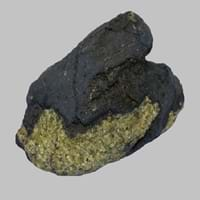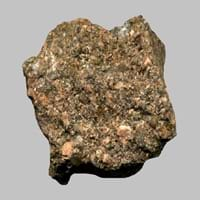Definition
Basanite is a black basaltic rock which mainly contains plagioclase, augite, olivine and nepheline and is formerly used as a touchstone
Arkose is a sedimentary rock, specifically a type of sandstone containing at least 25% feldspar
Discoverer
Unknown
Alexandre Brongniart
Etymology
From Latin basanites + -ite
From Auvergne region of France used by a French geologist Alexandre Brongniart in 1826 who applied this term to some feldspathic sandstones
Class
Igneous Rocks
Sedimentary Rocks
Sub-Class
Durable Rock, Hard Rock
Durable Rock, Hard Rock
Group
Not Applicable
Not Applicable
Other Categories
Fine Grained Rock, Opaque Rock
Coarse Grained Rock, Opaque Rock
Texture
Aphanitic to Porphyritic
Clastic
Color
Black, Brown, Green, Grey, Red, White
Reddish Brown
Durability
Durable
Durable
Scratch Resistant
Yes
Yes
Appearance
Glassy or Pearly
Rough and Dull
Interior Uses
Decorative Aggregates, Homes
Decorative Aggregates, Homes, Interior Decoration
Exterior Uses
As Building Stone, Garden Decoration, Office Buildings
Paving Stone, Office Buildings
Other Architectural Uses
Whetstones
Whetstones
Construction Industry
Arrowheads, Construction Aggregate, Cutting Tool, Spear Points
Cement Manufacture, Construction Aggregate, for Road Aggregate, Production of Glass and Ceramics, Raw material for the manufacture of mortar
Medical Industry
Not Yet Used
Not Yet Used
Antiquity Uses
Artifacts, Monuments
Artifacts, Sculpture, Small Figurines
Commercial Uses
As a touchstone, Creating Artwork, Gemstone, In fire-starting tools, Manufacture of tools, Metallurgical Flux, Jewelry, To ignite fire, Used in flintlock firearms
In aquifers, Soil Conditioner, Source of Magnesia (MgO), Tombstones
Types
Nepheline-Basanite, Analcite-Basanite and Leucite-Basanite
Not Available
Features
Clasts are smooth to touch, Easily splits into thin plates, Has High structural resistance against erosion and climate, Used as a touchstone
Available in Lots of Colors and Patterns, Generally rough to touch, Is one of the oldest rock
Archaeological Significance
Monuments
Used
Not Yet Used
Famous Monuments
Data Not Available
Not Applicable
Sculpture
Not Yet Used
Used
Famous Sculptures
Not Applicable
Data Not Available
Pictographs
Not Used
Not Used
Petroglyphs
Not Used
Not Used
Figurines
Not Yet Used
Used
Formation
Basanite is a fine-grained, hard rock that forms when bits of lava shoot out of volcanoes.
Arkose rock forms from the weathering of feldspar-rich igneous or metamorphic rock, most commonly granitic rocks, which are primarily composed of quartz and feldspar.
Mineral Content
Augite, Feldspar, Ilmenite, Olivine, Plagioclase
Calcite, Clay, Clay Minerals, Feldspar, Micas, Quartz
Compound Content
Potassium Oxide, Sodium Oxide, Silicon Dioxide
Aluminium Oxide, CaO, Iron(III) Oxide, Potassium Oxide, MgO, Sodium Oxide, Silicon Dioxide
Types of Metamorphism
Burial Metamorphism, Cataclastic Metamorphism, Contact Metamorphism, Regional Metamorphism
Not Applicable
Types of Weathering
Chemical Weathering, Mechanical Weathering
Biological Weathering, Chemical Weathering, Mechanical Weathering
Types of Erosion
Chemical Erosion, Coastal Erosion, Glacier Erosion, Sea Erosion, Water Erosion, Wind Erosion
Coastal Erosion, Glacier Erosion, Water Erosion, Wind Erosion
Grain Size
Fine Grained
Coarse Grained
Fracture
Uneven, Splintery or Conchoidal
Conchoidal
Porosity
Highly Porous
Highly Porous
Luster
Waxy and Dull
Dull
Cleavage
Non-Existent
Not Available
Toughness
1.5
Not Available
Specific Gravity
2.5-2.8
0
Transparency
Translucent to Opaque
Opaque
Density
2.7 g/cm3
Not Available
Specific Heat Capacity
Not Available
Resistance
Heat Resistant, Impact Resistant, Pressure Resistant, Wear Resistant
Heat Resistant, Impact Resistant, Pressure Resistant
Deposits in Eastern Continents
Asia
Not Yet Found
China, India, Kazakhstan, Mongolia, Russia, Uzbekistan
Africa
Uganda
Namibia, Nigeria, South Africa
Europe
Germany, Hungary, Italy, Spain
Austria, Denmark, Germany, Great Britain, Netherlands, Norway, Poland, Sweden, Switzerland, United Kingdom
Others
Greenland, Mid-Atlantic Ridge
Greenland
Deposits in Western Continents
North America
USA
Canada, USA
South America
Bolivia, Brazil
Brazil
Deposits in Oceania Continent
Australia
New South Wales, New Zealand, Queensland, South Australia, Western Australia
New South Wales, New Zealand
All about Basanite and Arkose Properties
Know all about Basanite and Arkose properties here. All properties of rocks are important as they define the type of rock and its application. Basanite belongs to Igneous Rocks while Arkose belongs to Sedimentary Rocks.Texture of Basanite is Aphanitic to Porphyritic whereas that of Arkose is Clastic. Basanite appears Glassy or Pearly and Arkose appears Rough and Dull. The luster of Basanite is waxy and dull while that of Arkose is dull. Basanite is available in black, brown, green, grey, red, white colors whereas Arkose is available in reddish brown colors. The commercial uses of Basanite are as a touchstone, creating artwork, gemstone, in fire-starting tools, manufacture of tools, metallurgical flux, jewelry, to ignite fire, used in flintlock firearms and that of Arkose are in aquifers, soil conditioner, source of magnesia (mgo), tombstones.










